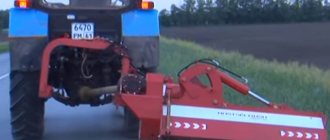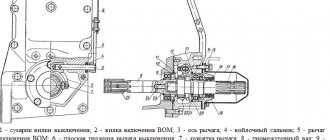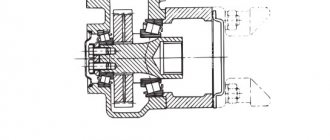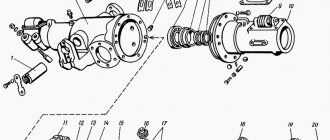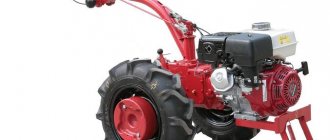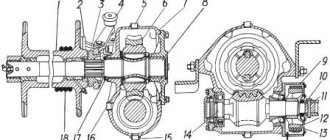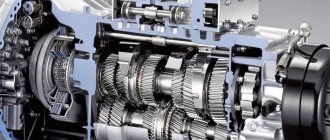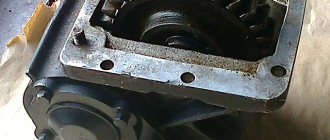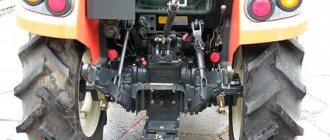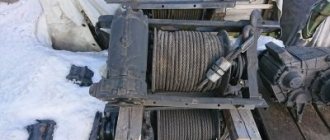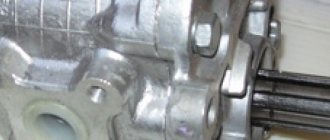Universal row-crop tractors MTZ 80, MTZ 82 are used to perform a wide range of mechanized work, including aggregation with various active, mounted, trailed specialized mechanisms. To transfer power from the tractor to the equipment used, the equipment of the above brand is equipped with power take-off shafts. The drive is carried out from splined tips connected by appropriate couplings to the machines being aggregated.
Operation of the mower from the rear PTO of the MTZ 82
Rear PTO device MTZ 80.
The PTO mechanism is part of the tractor transmission, the rotation of which is carried out from the engine flywheel or from the machine’s gearbox.
Planetary PTO gearbox.
The PTO design includes a planetary engagement mechanism, the function of which is to engage and transmit rotation to the connecting splined shaft. The gearbox is located in the rear part of the tractor rear axle housing. In custom designs of planetary gearboxes, shaft 28 is made universal, composite with replaceable shanks with 8 for a rotation speed of 540 rpm. or 21st spline at a speed of 1 thousand rpm. PTO rotation.
planetary gear unit for rear PTO engagement
The gearbox is controlled by two friction belts 35 and 34 (in the figure). One brake band is on the carrier drum, the other is on the drum connected to the sun gear through a splined clutch. The switching lever is located on the right side of the driver and has two positions: lever forward - “PTO off”, lever back - “PTO on”. The movement from the lever is transmitted by rods to a spring amplifier, connected through the lever to the friction belt control axis. During operation, you need to pay attention so that the switching lever does not rest on the floor of the cab. This will prevent the mechanism from slipping.
Gearless mechanisms
In addition to the geared PTOs that were discussed above, there are also gearless gearboxes designed for power take-off. Their distinctive feature is the simplicity of their design. They also have a single gear ratio.
To select the required power in this case, a transfer case input shaft is used, at the end of which special splines are provided. These types of boxes are mounted on the end part of the transfer case housing in the upper part of the structure.
The PTO shaft at one end has similar splines as the transfer case primary shaft. At the other end, a flange is installed to secure the drive shaft of additional automotive equipment.
To turn on the selection box, you need to lock the two shafts using a special carriage. The latter moves due to the power fork located on the rod. The rod has two fixed standard positions. If this is the left position, then the selection box is in active, that is, working condition. The right position means that the PTO is off.
You can change the direction of rotation of the PTO shaft by engaging reverse gear at the vehicle's gearbox.
If you study the design of the box in question, you will notice one important nuance. This is the use of a plunger pump. It is needed to lubricate the components of the PTO housing and transfer case at a time when the car is stationary, but additional equipment is working. This prevents possible wear of parts due to lack of lubrication. The pump forcibly supplies oil to the components, thereby lubricating and cooling them.
The plunger-type pump itself is installed in a housing located directly in the boss of the PTO cover. It includes the plunger pump itself, as well as a non-return, suction and mandatory discharge valve.
To control such a selection box, a lever is used, directly connected to the rod and located in the cabin of the machine or other vehicle.
The operation of power take-offs without a gearbox has been sorted out. Now it’s worth looking at 2 more types of knots.
PTO operating modes and rotation speed switching
Cam clutch 39 performs the function of switching PTO operating modes (synchronous - independent) and transmitting rotation to the gearbox.
Independent mode
In independent mode, the clutch receives rotation from a shaft passing through the hollow intermediate shaft of the gearbox, which transmits the rotation of the engine flywheel through a two-speed gearbox located at intervals in the crankcase. The independent mode is activated at low idle speed or with the engine turned off using the claw clutch control lever. When switching with the engine off, to ensure that the coupling splines match, turn the splined drive shaft of the rear PTO by hand.
Synchronous mode
In synchronous mode, the clutch works with the drive gear of the second stage of the tractor gearbox when the transmission is running. The rotation frequency depends on the speed of movement and is 3.5 shaft revolutions per meter of travel. The mode is activated when the diesel engine is running, after engaging the gear and smoothly engaging the clutch.
The lever for switching PTO operating modes is located at the base of the driver's seat. When turning the lever to the extreme left, the “synchronous” mode is activated, and when turned to the right, the “independent” operating mode is activated. The middle position is “neutral”. The selected lever position is held by a lock.
Independent mode rotation speed
Changing the speed of the independent PTO mode is carried out with the engine turned off, through a driver installed in the lower part of the tractor body, connected by a rod with a sliding gear block. Turning the leash clockwise turns on the speed of 540 rpm. in the opposite direction - 1 thousand rpm. The position of the leash is fixed by a spring-ball lock mounted on the shift fork.
Varieties
As you already understand, PTO is used on machines to transfer energy to additional equipment.
Based on the mechanisms being driven and the requirements for the device, there are different types of existing power take-offs. They may differ from each other according to several principles:
- Number of steps. This defines the pitch between the available working mechanisms.
- Presence of reverse. Some components, such as pumps, only rotate in one direction. If this is a truck crane, then the PTO should work in two opposite directions.
- Gear ratio. The change in angular velocity and transmitted torque depends on this value.
- Number of shafts. It may vary depending on the design of the particular box.
- The location of the components that are included in the box.
- Control special signal. It can be mechanical, using a lever or through the on-board computer.
When getting acquainted with the design of power take-off boxes, you should definitely take into account possible options for their location.
Basically, systems can be installed at the following points:
- on the side relative to the vehicle’s gearbox;
- on the end side of the box;
- in the gearbox housing;
- together with the transfer gearbox.
The PTO requires mandatory lubrication, which depends on the installation features and the presence of its own oil reservoir in the design. Most often, lubrication is carried out using oil and the crankcase of the main box.
It also happens that the PTO has an upper location. In this case, a pump is additionally used. It allows lubricant to be supplied to the assembly.
All boxes used on machines can be divided into several subcategories. They are:
- reversible;
- gearless;
- dependent;
- independent.
Each option requires separate consideration for a better understanding of the essence and operating principle of the device.
Side PTO
Side PTO is installed to drive mechanisms mounted on the front linkage or on the side of the tractor. A separate gear housing of the independent “Side PTO” is attached to the hatch on the left side of the MTZ 80(82) gearbox housing. The drive is carried out from the driven gear of first gear and reverse gear. The drive shaft has a standard eight-spline end and is covered with a protective cover.
Side PTO gearbox MTZ 82 (80)
The “Side PTO” activation lever is located above the floor on the left side of the driver’s seat. Activation is carried out by moving lever 1 upward, while rod 2 turns the lever and the roller with the driver, moving the gear on the splines of shaft 7 , bringing gear 4 into engagement. “Side PTO” is engaged when the clutch is disengaged.
By switching the reduction gearbox, two shaft rotation speeds of 535 and 735 rpm are obtained in independent mode.
The “Side PTO” synchronous drive is used on tractors of the cotton modification MTZ 80X. The drive is carried out by a gearbox from the drive gear of the final drive of the rear axle. If the tractor is equipped with a parking brake, the side synchronous shaft is installed only on the left. Installation of a separate gearbox is carried out to the rear axle brake housings. The connection is made using a splined coupling. The control lever is brought into the cabin. Synchronous drive shafts are installed perpendicular to the axis of movement of the tractor.
Motoblock drive motors
A walk-behind tractor with a domestically produced power take-off shaft has a drive that consists of a classic internal combustion engine. Units classified as light or medium are equipped with four-pin gasoline engines. Some outdated walk-behind tractors still have two-pin gasoline engines.
Machines considered heavy most often have diesel engines, the operation of which is ensured by the following systems:
- fuel receipts;
- cooling;
- lubricants;
- starting - starter;
- gas distribution;
- ignition
The engine crankshaft transmits rotation to the gearbox through its gearbox. It is possible to stop such a unit without stopping the drive. When changing gear, the gearbox is disconnected from the engine. This prevents jerking when the walk-behind tractor with the power take-off shaft starts moving, and you can also stop the unit without turning off the drive.
The coupling occurs through the clutch. The clutch is controlled using a lever. To ensure that the walk-behind tractor operates smoothly and without jerking, an additional unit is installed on heavy machines - with a differential. This mechanism eliminates the parallel rotation of the wheels, which makes it possible to set the wheels to different rotation speeds.
PTO malfunctions
1 The inability to switch modes is caused by wear of the jaw clutch. In this case, disconnect the gearbox from the rear axle mechanism and replace the worn parts. 2 If the shaft continues to rotate after being turned off or the stability of the PTO rotation speed in the on position is disturbed, in such cases the brake bands should be adjusted or replaced.
3 Difficult switching on or impossibility of switching on indicates a breakdown of the spring switching amplifier. Eliminate by replacing the spring.
Please note that in order to avoid injury, dismantling and installing the spring amplifier is done in strict sequence:
- Move the power lever to a position in which the holes on the lever and the rear axle housing coincide.
- A bolt is screwed into the holes to secure the lever.
- The control nut 4 on the adjusting bolt 5 cup 2 , and the bolt is screwed in over the entire length of the thread, compressing the spring 1 .
- The locking bolt securing the spring is tightened in the cup body.
- Having fixed the spring, unscrew the adjusting bolt and remove the amplifier. Using a press, disassemble the glass and replace faulty parts.
- Assembly and installation of the unit is carried out in the reverse order.
Planetary gearbox rear PTO MTZ
4 The appearance of hum and noise during PTO operation indicates wear of the bearings and parts of the planetary gearbox. To eliminate the breakdown, the gearbox is removed from the rear axle housing and the unit is completely disassembled, followed by defect detection and replacement of parts.
Production
Delivered to tractor dealerships,
mainly assembled by the Minsk Tractor Plant. But in the near future, Belarusian tractor manufacturers are intensively entering into production cooperation, opening assembly lines, developing their network of equipment maintenance points, and increasing the supply of spare parts.
In Russia there is an assembly facility in Saransk, which is based on the installation of Belarusian-designed tractors from ready-made components and assemblies supplied from the head assembly flow. Locally assembled Russian cars from finished Belarusian-made parts are somewhat cheaper.
Adjustment.
Adjustment of the friction tapes of the PTO gearbox and the engagement lever is carried out in the following order:
- The shift axis is fixed by aligning the holes on the lever and the housing of the rear axle 7 of the tractor with a 5 m10x60 mm bolt.
- Disconnect the spring amplifier from the lever (following the above dismantling procedure), having previously compressed the spring with a bolt and secured it in a compressed state with a locking bolt 1 screwed into the hole in the amplifier housing 2 .
PTO control drive MTZ 82(80)
- The adjusting screws 8 bands are screwed in all the way without excessive force, then released one and a half turns. In this case, the PTO shaft shaft should rotate freely under the force of your hand. If rotation is difficult, unscrew the screws another “half turn”.
- The position of the screws is fixed by a plate in the cover that closes the adjustment hatch.
- By connecting the lever to the fork, adjust the position from the lower plane of the cabin floor to the control lever fork. In the on position, the distance should be 45-50 mm. The articulated forks on the threads of the lever are fixed with control nuts.
Advantages and disadvantages of the tractor
During operation, the costs of maintaining a Minsk tractor are minimal. And this is the main factor that is valued by farmers. The car has high reliability. And on Russian fields, the tractor is in no way inferior in productivity to its European counterparts. And sometimes even surpasses them. Over the years, the Minsk tractor has gained a reputation as “indestructible equipment”, which cannot be affected by off-road conditions, temperature changes, dust, heat, rain, snow and frost.
The tractor is easily aggregated with a large number of attachments. Easy to use. The developers tried to create a certain level of comfort for the driver in the cabin (as far as this word is applicable for cars developed during the USSR). The machine meets modern ergonomic standards.
Disadvantages and typical problems
In general, the engine is insensitive to fuel quality. But if the quality of diesel fuel is poor, the diesel engine may stall and not start at all. What to do? The problem is often solved by adjusting the injectors and changing diesel fuel.
If there is black smoke from the exhaust pipe, immediately reduce the load on the engine. If white and blue smoke occurs, it is necessary to carry out maintenance of the fuel system and adjust the thermostat.
A particularly alarming symptom of the “health” of equipment is knocking in diesel engines. You should stop work, carry out diagnostics, and replace severely worn rings and bushings.
If oil consumption is excessive, worn parts are also replaced and piston rings are replaced.
Output of the rear PTO to the front linkage of the tractor.
To drive MTZ 82 equipment mounted on the front linkage, an additional set of parts and assemblies is used to output torque from the rear PTO.
The kit includes:
- An additional gearbox, which is attached to the rear PTO housing and converts rotation from the drive shank towards the front linkage under the rear axle housing.
- A system of brackets and fasteners for converting the rear linkage, providing space for mounting an additional gearbox.
- System of intermediate supports and fasteners for installing the cardan shaft.
- Cardan shaft transmitting rotation from the additional flange coupling. gearbox on the front linkage.
The kit parts are attached to standard holes on the transmission housing and frame of the MTZ 82 (80) tractor.
Converting gearbox for rear PTO MTZ
Cardan transmission of the front PTO drive MTZ 82 with supports
Front support bracket for front PTO MTZ
Front support and front linkage PTO drive shaft
A little history
The MTZ series of universal tractors began to be created in the 1970s after a special resolution of the USSR Council of Ministers. The government decided to introduce a powerful row-crop tractor (up to 80 hp) into the agricultural sector. The development base was a modernized version of the MTZ-50 tractor. Many configurations were introduced into the design of the vehicle; the casing and cabin underwent modernization.
The MTZ tractor series began to be created in the 1970s
A new engine with increased power was installed on the tractor. In 1972, the first tests of the MTZ-82 turned out to be very successful. Based on the test results, a list of aggregated equipment was created; in total, more than 230 devices were created for various types of work. The acceleration of the tractor up to 30 km per hour made it likely to be used for transport work.
The first tractor left the assembly line of the Minsk plant in 1974. The first reviews of MTZ 82 were positive. And Belarusian tractor manufacturers began to increase production volumes. For almost four decades, the equipment of the Minsk plant has cultivated fields on almost all continents of the world. They are especially popular in developing countries of Asia, Africa, and Latin America.
Practical tips for use.
The design features of the drive shafts of the machines used often have the character of open, actively rotating parts. To avoid injuries and emergency breakdowns when working with drive machines, you should be careful and take into account the following aspects and rules:
- The machine coupled with the tractor must be in good technical condition.
- The machine must be used strictly for its intended purpose and in appropriate conditions. When preparing for PTO operation, you need to make sure that the splines of the shaft shank and the drive coupling of the machine used match (8 splines or 21). If there is a discrepancy, the shaft shank must be replaced.
- Check the presence and reliability of fastening of protective covers, rotating parts of the drive machine, adjustment of the safety clutches and serviceability of the cardan joints of the drive.
- The drive is installed directly at the place where the unit is used. The connection is secured with a special locking bolt when the recess on the shaft splines coincides with the hole in the coupling of the cardan drive of the machine being coupled.
- The route and turning radius must correspond to the design features of the unit.
- In order to avoid overloading the unit structures, the choice of movement speed, processing depth, working width, and operating mode of the unit must comply with the standards and requirements.
- Disconnection is done after the shaft has completely stopped in the neutral position of the drive mode switching lever and the PTO is turned off.
With an optimal balance of engine speed and load, a significant reduction in fuel consumption per unit volume of work done by the unit is achieved. If agrotechnical and technological conditions for performing work do not limit the speed of movement of the unit, the gear is selected based on the optimal load without signs of overloading the tractor and the mechanisms of the drive machine used. When working with energy-intensive machines with insufficient engine power, in a situation where the unit’s performance is not fully loaded at speeds above 7 km/h, a gearbox reduction gearbox is used.
Top best models
Below are several models that most interested users and, in their opinion, were among the best units. From them you can choose and buy the best unit for yourself.
Salyut 100-X-M1
This device is equipped with a 6.5-horsepower Honda gasoline engine, a 3.6-liter fuel tank, a gear transmission, and a power take-off shaft to allow the use of a wide range of attachments. All important components, including the pulley, are placed in a plastic casing, which reliably protects them from dust and foreign objects. The handle has a speed mode switch (2 forward, 1 reverse), which makes it convenient for the operator to control the walk-behind tractor. Its processing width is adjustable and can be set at 30/60/90 cm. The weight of the product is 78 kg, the cost is about 48,000 rubles.
Neva MB-23
The device is equipped with an American Briggs&Stratton 10 hp engine. and is designed for intensive, heavy work. To equip it, a gear-chain gearbox and a 3-speed gearbox are used. Distinctive features of the Neva MB-23 motor unit are 140 mm ground clearance, adjustable track (normal 320 mm, with extensions - 570 mm), good traction indicator equal to 160 N (kgf). This walk-behind tractor can work on all types of soil and even cultivate virgin soil. Its weight is 105 kg, and the average cost is 50,500 rubles.
Agate KhMD-6.5
The model is equipped with a Japanese-made 6.5-horsepower diesel engine and is perfectly adapted to harsh operating conditions. It consumes fuel economically (up to 1.2 l/hour) and demonstrates high performance. This walk-behind tractor is equipped with an improved muffler design, which provides low levels of vibration and noise, and large pneumatic wheels, allowing it to easily move across the field. Its processing width reaches 90 cm, and the plowing depth is 25 cm. The weight of the unit is 85 kg, the cost is 25,600-29,300 rubles.
Scout 135DE
To equip the Scout 135 DE walk-behind tractor with a power take-off shaft, a four-stroke diesel engine with 9 hp is used. with a 5.5 liter fuel tank. It is equipped with 10 cultivation cutters, providing a working width from 75 to 135 cm and a plowing depth from 8 to 30 cm. This unit is very powerful and is designed for processing large areas. It has high cross-country ability even in uneven terrain, where it is difficult for conventional motor vehicles to properly loosen the soil. Its weight is 142 kg, and the price starts from 52,900 rubles.
Huter GMC-9.0
This is another representative of heavy garden motorcycles equipped with a power take-off shaft. The model is equipped with a four-stroke engine with a power of 9 hp, a 5-liter fuel tank and has a three-speed gearbox with a reverse function. In one pass, it provides processing of a strip with a width of 115 cm. The unit is characterized by good stability and maneuverability due to the presence of large pneumatic wheels. Its weight is 135 kg. The price for it starts from 43,800 rubles.
Sources
- https://dostavka99.ru/specnaznacheniya/chto-takoe-vom.html
- https://oxotnadzor.ru/kakiye-byvayut-valy-otbora-moshchnosti/
- https://dlobal.ru/vom-val-otbora-moshhnosti-na-minitraktor-svoimi-rukami/
- https://1sadteh.ru/komplekt/val-otbora-moshhnosti.html
- https://tractoramtz.ru/prochie/chto-takoe-val-otbora-moshhnosti.html
- https://lkard-lk.ru/avtolyubitelyu/val-otbora-moschnosti-chto-eto-takoe
- https://usbravo.ru/dlya-chego-nuzhen-mekhanizm-otbora-moshchnosti/
[collapse]
